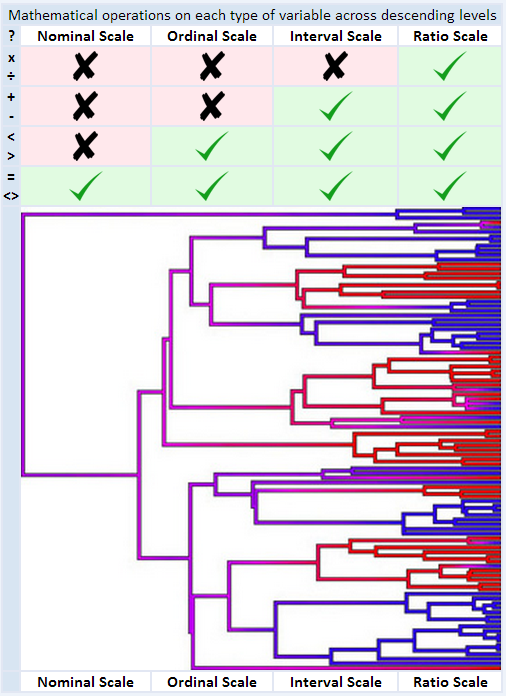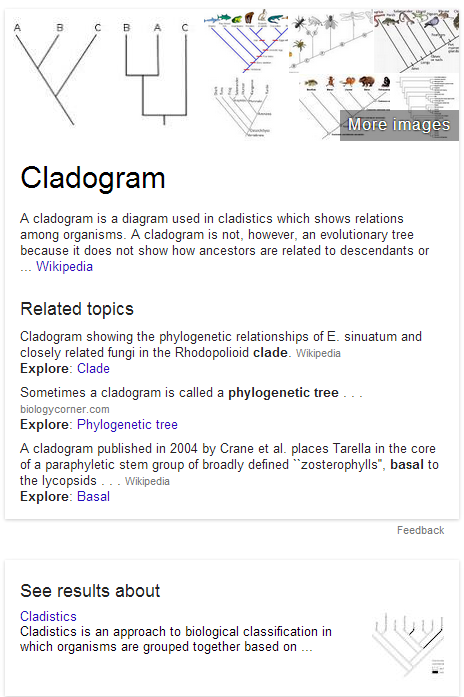KI:
All we can do is provide unique identifiers that denote entities in a
given world view (or situation)...
Basically, as our world view expands we discover new insights etc.
JFS:
Yes. The world is a continuum. We can name some discrete points, but we can't describe a continuum with any set of discrete identifiers.
Some insights can be described in words, but there are too many subtle variations -- uncountably many.
Symbols like '+' are abbreviations for the words or phrases. Some diagrams are designed to be translated to and from discrete symbols.
But no words can describe a complex image -- such as a human face.
BRS:
So we pick "dimensions" (attributes, qualities, facets) that are significant in a particular context -- and then assign values to those attributes (hair color? "brown")
JB:
Given enough time we humans can and must be able to conjure up an
appropriate image to get an idea across if both are professionals in
the same discipline.
JFS:
There's a big difference between "conjuring up" and specifying.
BRS:
Well -- maybe "conjuring" depends on some kind of very sensitive inductive reasoning -- "empathy" or something like that.
The real issue is -- understanding the intention of the speaker. Of the infinite number of possible interpretations of the words – what is the speaker’s intended meaning?
This depends on something more than strict empirical reading of the data, which may not contain the all clues needed for interpretation.
QUALITY AND QUANTITY
For me, the interesting question has been -- "What is a qualitative variable?"
How do qualitative variables relate to quantitative variables -- and -- the critical issue -- can some kind of algebraically- determinate mapping be constructed between them?
If the attribute "hair color" is a dimension, "brown" can be a "value" on that dimension. And "brown" -- not usually thought of as a quantitative variable -- can be interpreted in a linear way in terms of wavelength. This linkage between “brown “and “wave length” indicates the kind of bridge-work to be defined.
WHAT IS THE DIMENSIONALITY OF A QUALITATIVE VARIABLE?
In pursuit of the so-called "Integral Frame" -- essentially composed of dimensions as I understand it -- I want to ask the question "What is the dimensionality of a qualitative variable?"
If hair color is a dimension, the values of the dimension are fairly easy to define (blonde, red, brunette, black, etc.) And if needed, we could zero in on the color -- though no doubt, the color is not uniform, and since organic objects have fractal boundaries, we'd have to settle for an oversimplified monotone value.
In the social sciences, qualitative variables are common. A strong case could be made that a major reason for divisions among academic disciplines is the incommensurate variables they use. The more highly "qualitative" a variable is, the less certain or specified are its exact characteristics.
But still -- in the context of stipulation ("the variable-label means what the speaker intends it to mean" – which is an essential principle when meaning is absolutely context-dependent) -- it might be very possible to dimension a cascade of interpretations grounded in quantitative variables -- as long as the speaker is prepared to be specific about the qualitative terms.
DESCENDING LEVELS
For me -- this "Integral Frame" concept revolves around the bridge from high-level abstract holism to low-level to low-level empiricism, and takes a general form initially defined by psychologist Stanley Smith Stevens.
This graphic shows his four types of variables, and indicates the mathematical operations that are possible on each type.
In the cladogram – a concept from biological taxonomy, which it might possible to generalize as a theory of concepts -- holism is shown on the left and empiricism on the right.
“Nominal” and “Ordinal” are qualitative variables and “Interval” and “Ratio” are quantitative.

CONTINUITY IN X AND Y
Our descriptions of concrete/empirical experience involve a translation from the sensory encounter with continuity through a process of “ascending hierarchical induction” into broader and more abstract categories – that tend to lose their exact connection with precise measurement. Maybe we perceive the world in “holistic gestalts”, which are “chunked units” composed of implicit (unspecified) parts, which we see as wholes.
The right side of this diagram indicates the “continuum” John refers to (the vertical Y axis) – and the ascending categories to its left (along the X axis) indicate a hierarchy of increasingly abstract terms in increasingly broad categories. How “close to continuity” can this model get? Well – the answer is probably “very close” – but if so – in how many quantitative dimensions can we measure variability of abstract objects at higher levels? The complexity would explode, so we need to make limiting choices relative to our purposes (our intentions).
It’s also interesting to note that the incremental scale in the left-to-right axis does not imply rigid incremental uniformity in levels (as we might often assume in biological taxonomies – “phylum/class/order/family/genus/species”, etc.). The X and Y axes can both be defined as continuous, or potentially continuous. This might be important if the algebraic bridge-work across descending levels of categories can be made determinate.


